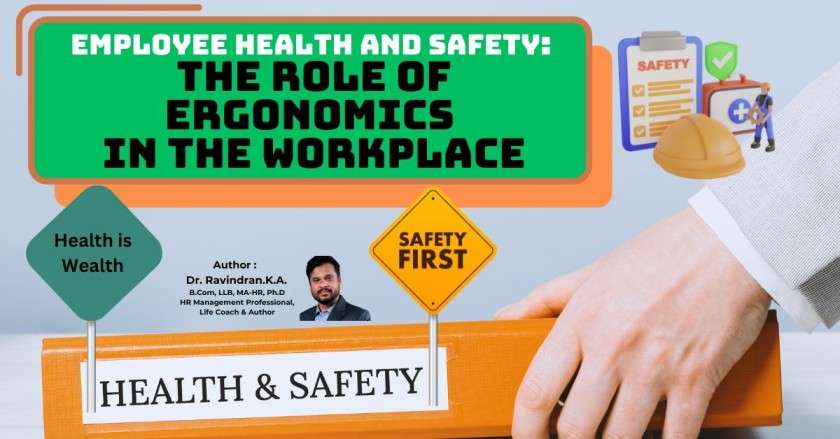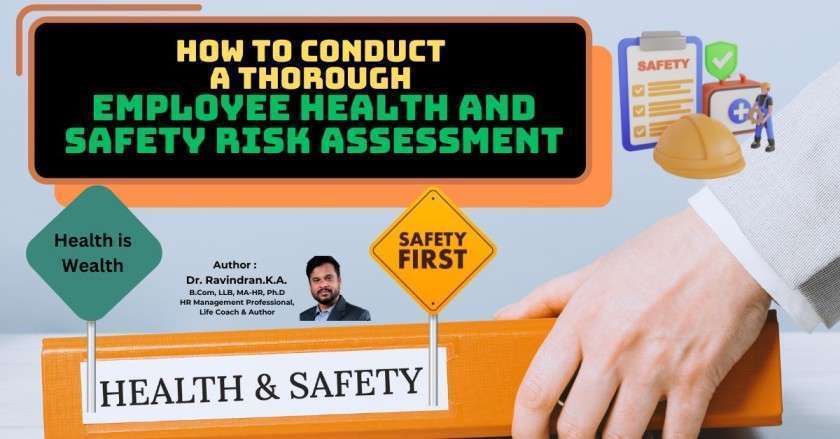Improving Employee Health and Safety: 5 Strategies for Small Businesses
Is your small business doing enough to keep your employees safe and healthy? In today’s fast-paced world, having a strong and engaged team is key to success. Making sure your employees are healthy and safe is not just the right thing to do. It’s also a smart move that can help your business grow.
Thank you for reading this post, don't forget to subscribe!Illness, injury, or burnout can cause more absences, less work done, and high costs for workers’ compensation or lawsuits. But, by focusing on a safe and healthy workplace, you can make your employees happier and more productive. This article will share five ways small businesses can improve employee health and safety. These steps will help increase productivity and make the workplace safer.
Key Takeaways:
- Promoting employee health and safety is crucial for small businesses to thrive and avoid costly consequences.
- Regular equipment checks, safety training, and talking openly with employees are key to a safe workplace.
- Spotting and fixing workplace dangers can greatly lower the chance of accidents and injuries.
- Getting employees involved in health and safety efforts builds a culture of teamwork and ongoing improvement.
- Keeping detailed records and learning from past incidents helps small businesses get better at safety over time.
1. Recognizing the Importance of Employee Well-being
For small businesses, having a healthy and productive team is key. Studies show that how work is designed can greatly affect well-being and health, including healthcare costs. Things like job demands, work-life balance, and the work environment cause stress for many workers.
Reducing Burnout and Turnover
Burnout is a big issue, with research showing that those feeling burnout are 63% more likely to take sick days. To tackle this, companies must focus on making a positive work environment. This helps to reduce burnout and turnover. For example, a well-known company M/s ABC saved $250 million on healthcare costs over ten years with wellness programs, getting a return of $2.71 for every dollar spent.
Impact of Work Design on Health and Well-being
Changing work to support employee health and well-being is a smart move. This means looking at job demands, giving enough job resources, and thinking about how workplace design affects health. By making work a positive place, companies can boost employee engagement and overall well-being.
| Key Statistic | Insight |
|---|---|
| 85% of companies state that wellness programs support employee engagement. | Investing in employee well-being can lead to higher levels of engagement and productivity. |
| 78% of employers offer wellness programs to attract and retain talent. | Prioritizing employee health and well-being can be a competitive advantage in attracting and retaining top talent. |
| 54% of employees in April 2020 were primarily concerned about job security during the COVID-19 pandemic. | Addressing employee concerns about job security can help alleviate stress and improve well-being. |
By focusing on employee well-being, small businesses can build a strong, engaged team. This leads to a healthier, more productive work environment.
2. Employee Health and Safety: A Comprehensive Plan
Creating a strong health and safety plan is key for small businesses. It helps protect their most valuable asset – their employees. This plan starts with finding and fixing workplace hazards. These can be anything from chemicals stored wrong to broken machines and tripping spots.
Identifying Workplace Hazards
Doing detailed risk assessments helps spot hazards at work. This means looking at the tasks, tools, and materials used. It also means checking how work is done to find possible dangers. By doing this, small businesses can focus on the biggest risks and make safety plans to tackle them.
Regular Equipment Inspections
Keeping equipment safe and working right is vital for a good safety program. Having a regular check-up schedule for equipment inspections helps catch and fix problems fast. This lowers the chance of things breaking down and causing accidents. Taking care of equipment maintenance also helps follow the rules and keeps the workplace safe.
| Benefit | Statistic |
|---|---|
| Improved employee cooperation | 25% increase in employee cooperation due to Comprehensive Workplace Health and Safety (CWHS) Program implementation |
| Reduced health costs | $2.50 saved for every $1 invested in CWHS Programs |
| Reduced absenteeism and turnover | 15% reduction in absenteeism and 12% reduction in employee turnover rate with CWHS Programs |
| Decreased workplace incidents | 20% decrease in workplace injuries and incidents after initiating CWHS Programs |
| Increased productivity and morale | 18% improvement in creativity and productivity, and 22% increase in employee satisfaction following the implementation of CWHS Programs |
With a solid workplace health and safety plan, small businesses can keep their employees safe. They also get better compliance, incident prevention, and work better overall.
3. Prioritizing Safety Through Employee Engagement
Engaged employees are key to a strong safety culture. By letting your team take part in health and safety, you create a place that values well-being and always gets better.
Dedicated Training for New Hires
When you bring new people on board, it’s a great chance to build a solid safety base. Offer detailed safety training that covers your company’s rules, steps, and what to do in emergencies. This makes sure your team knows how to stay safe right from the start, lowering the chance of workplace accidents and injuries.
Encouraging Open Dialogue
Make a space where everyone feels free to talk about their worries, ideas, and thoughts. Regular meetings and ways to give feedback help you keep up with what they need and fix safety hazards early. This teamwork boosts employee engagement and shows your dedication to safety culture.
When employees are involved in safety, they become your best team in making things better. By using their real-world knowledge, you can spot areas to improve and put in place good solutions. This keeps your team safe and efficient.
“Engaged employees are more likely to report hazards and common risks like slips and trips.”
4. Learning from Incidents and Maintaining Records
Small businesses need to see incidents as chances to learn and get better. Incident investigation helps find out why accidents happen and how to stop them from happening again. By looking closely at what went wrong, businesses can find ways to get safer at work.
Keeping detailed records of checks, training, and reports of incidents is key. This info helps small businesses see trends and make smart choices to improve their safety program. For example, looking at incident reports can show patterns and help plan ahead to fix problems.
- Treat incidents as chances to learn and improve
- Do deep incident investigations to find the real causes
- Keep detailed records of all safety stuff and incidents
- Analyze incident data to spot trends and areas for continuous improvement
- Use insights from investigations to make accident prevention better
By valuing learning and making decisions based on data, small businesses can turn incident investigation and record keeping into strong tools for better employee health and safety. This way, they can tackle weaknesses, make their safety better, and create a place that cares for their team’s well-being.
5. Fostering a Culture of Employee Health and Safety
Creating a strong safety culture is key for a small business’s health and safety program to thrive. It means changing how we think, showing leadership commitment to workers’ well-being, and making sure everyone feels they can help keep the workplace safe.
Changing the Mindset
Small business owners need to set the tone by valuing safety resources and making safety a part of the company’s culture. This means:
- Talking often about the importance of safety at work
- Offering detailed safety training to new and current employees
- Encouraging workers to speak up about safety issues without fear
- Thanking and rewarding safe actions and habits
Leveraging External Resources
Small businesses can use outside help to keep up with regulatory compliance, learn new safety methods, and stay informed. These resources include:
- Groups from the industry and trade organizations
- Government agencies and local authorities
- Safety experts and third-party advisors
- Online forums and places to share knowledge
By building a culture that values employee health and safety, small businesses can have a happy, involved team. This also helps avoid accidents, injuries, and legal problems.
“A strong safety culture is not just a nice-to-have, but a business imperative for small companies. It protects your most valuable assets – your employees – and sets the foundation for long-term success.”
Conclusion
As a small business owner in India, making sure your employees are healthy and safe is key. It’s not just about following the law. It’s a smart move for your company’s future. By having a strong plan, you can make a workplace that cares for your team’s well-being.
This article shows us the importance of focusing on employee well-being. It also talks about how to cut down on burnout and turnover. And how to make work that keeps people healthy and safe is crucial for a small business safety plan. When you let your employees help make health and safety decisions, you build trust. This leads to better compliance and fewer workplace accidents.
Having a solid Health and Safety Policy is the base for setting rules and safety steps. It also helps with emergency plans. Regular checks and looking at important numbers will keep your safety plan working well. This lets your small business do well while keeping your employees safe and happy.
FAQ
How can small businesses prioritize employee health and safety?
Small businesses can focus on employee health and safety by making a detailed plan. This plan should cover workplace dangers, get employees involved, learn from incidents, and build a safety culture.
What are the benefits of promoting employee well-being in the workplace?
Boosting employee well-being cuts down on burnout and turnover. It also lowers health care costs and raises productivity.
How can small businesses identify and address potential workplace hazards?
Small businesses should check equipment and tools often. They should keep detailed records of checks and incidents. Also, they should have a full health and safety program to follow rules and make a safer place to work.
What is the importance of employee engagement in the health and safety process?
Getting employees involved through safety training, talking openly, and regular updates is key. It helps spot problems and builds a safety culture.
How can small businesses learn from incidents and use data to improve their safety programs?
Small businesses should see incidents as chances to learn. They should look into what caused them and keep detailed records. This helps spot trends and make smart choices to better their health and safety plans.
What are the key elements of fostering a strong safety culture in a small business?
Creating a strong safety culture means changing how leaders think. They must really care about employee well-being and let everyone help keep the workplace safe. Small businesses can use outside help to keep up with rules and best ways to do things.
 hroptimum
hroptimum



